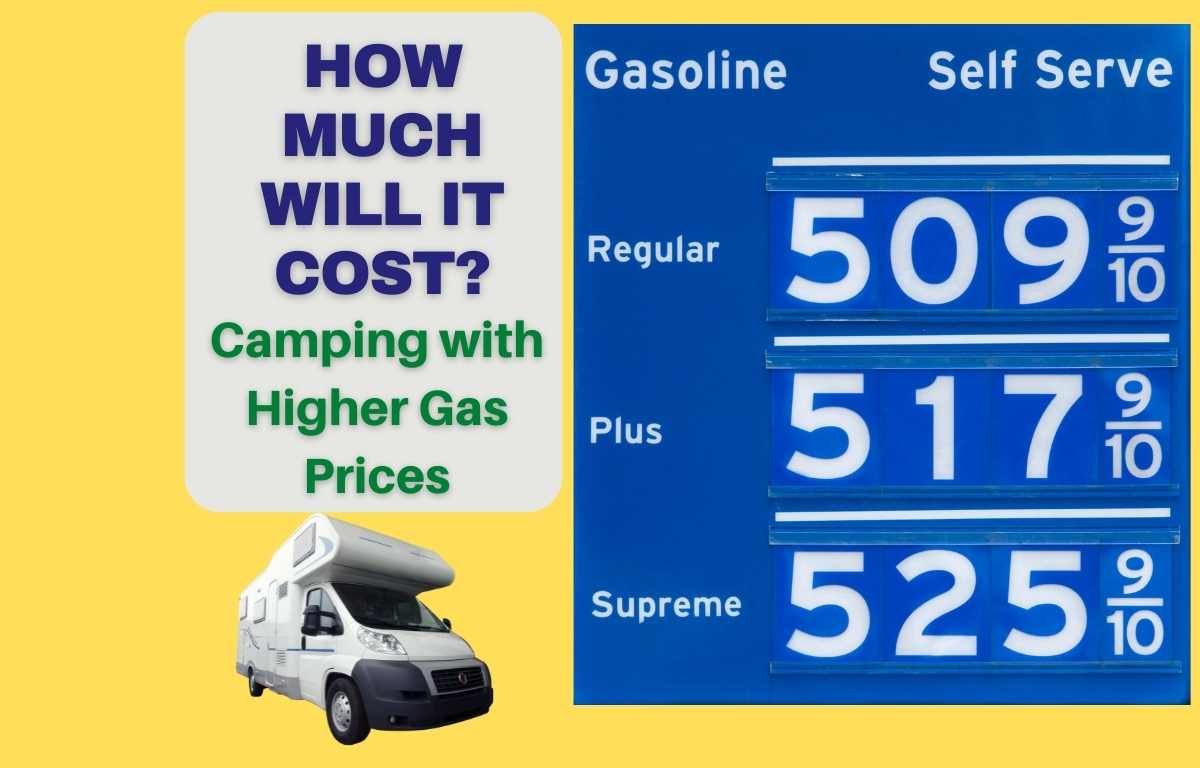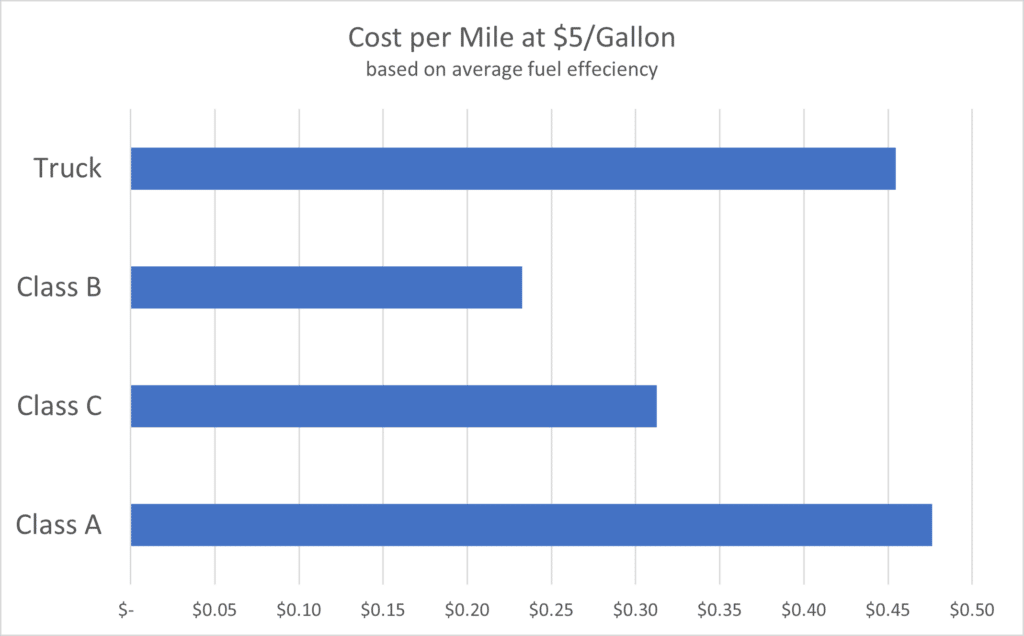There’s no question that the higher gas prices are putting a strain on everyone’s wallets. It’s one of the most noticeable increases in people’s monthly expenses. It’s easy to notice the higher gas prices while you stand at the pump, watching the price ticker climb as we fill the tank. Without question, it’s easy to feel the pain when you see that increased dollar amount at the pump compared to what it cost just a few months ago.

For RVers, seeing this increase can be shocking at the pump, especially if you have a large fuel tank or are using diesel. However, how much is high fuel prices impacting your travel budget? There’s no question it’s more expensive, but is it enough to keep your wheels firmly planted at home? When you take a closer look at the increased cost of traveling in 2022, you will get a better sense of the extra expense you need to budget for and decide if you can cut your expenses elsewhere to help keep you on the road.
Let’s look at some simple statistics to put it all into perspective. According to recent data, the average RVers travels about 4,500 miles annually. While this may seem high to some, it may be on the low end to others, especially full-timers. We’re just looking at the average. For some, these miles include traveling the country, visiting national parks, and covering dozens of states. However, for others, it may include multiple weekend trips to nearby campgrounds.
The first thing to realize with RVs, whether you’re driving a motorhome or towing a trailer, is that they require a lot of fuel to roll down the highway. As a result, some large Class A RVs and trucks will only get about 7 MPG when driving or towing. Even towing a smaller travel trailer will greatly impact your MPGs. On the opposite end of the spectrum, more fuel-efficient vehicles like Class B vehicles, a camper van, and more fuel-efficient vehicles towing small pop-up trailers will get the best gas mileage and may achieve up to 25 MPG. Below is a breakdown of the average fuel efficiency ranges for classes of RVs.
| RV Type | Range | Average |
| Class A | 8-13 | 10.5 |
| Class C | 14-18 | 16 |
| Class B | 18-25 | 21.5 |
| Truck | 7-15 | 11 |
When using the RV’s average travel distance of 4,500 miles, this can surely add up. Last summer, the average price of a gallon of gasoline was 3.06/gallon. The average price of diesel was $3.31/gallon. Using the average RV fuel efficiency of 14.75MPG, that 4,500-mile trip would have an overall cost of $948 for gas vehicles or $1,026 for diesel vehicles.

Prices today are very different. For example, at the time of this article, the average nationwide price for a gallon of gas is $4.59 ($5.54 for diesel). So the cost of that 4,500-mile trip would now be $1,422 for gas vehicles or $1,717 for diesel vehicles.
This estimate means that for an average RV at current prices, your annual fuel expense is $474 more for gas vehicles and $691 more for diesel vehicles in the summer of 2022. It’s important to note that is estimate is for the average RV fuel efficiency, and your cost of gas or diesel might be more or less than this number. However, while the MPG of your RV may fall on either side of the average, the ratio will be the same (about 50% more for gas or 67% more for diesel (at current prices).
The other thing that causes sticker shock to RV owners is that some RVs and trucks have large fuel tanks. When pumping 150 gallons of gas into your motorized RV, it is hard to spend that much money at one time at the gas station.
Now, let’s look past the annual fuel costs and use some examples of different types of camping trips to see how much more you may be spending this summer. Again, we’ll use the same average RV efficiency of 14.75 MPG.
Trip 1: A weekend camping trip to your local campground 30 miles away (60 miles total)
If you’re a weekend warrior, how much more is taking that camping trip costing you in 2022 vs. 2021. The gas price increase may be more manageable if you’re camping nearby at a campsite 30 miles away. At $4.59 per gallon, that 60-mile trip will use about 4 gallons of fuel. At the current average gas price, that will be about $18.63. For diesel, you’re looking at about $22. Comparing this to 2021, a trip to the local campground this summer will cost you an extra $6.00 for gas vehicles and $9 for diesel vehicles. The good news is that this isn’t a huge difference in costs. But, of course, if you take this trip ten times this summer, you’re looking at an extra $60 to $100 in fuel expenses for a summer of camping.
Trip 2: A weeklong excursion to a campsite 200 miles away (400 miles total)
If you’ve been planning that vacation to go camping at the beach this summer, but you have to drive 200 miles to get there, how much more will it cost you to make the trip this year? If you’re driving a gas vehicle, you’re looking at an additional $41 from what it would have cost you last year. A diesel vehicle will cost you an additional $59 in 2022. While this may seem like a lot of money, it shouldn’t prevent you from taking that trip. If you cut back a little on other expenses, you may be able to make up that additional expense.
Trip 3: A multi-week and multi-destination tip (2,000 miles of total driving)
If you have been planning a long multi-week road trip to the west coast long before the fuel prices shot up and are wondering if you can still afford the trip, here are the numbers. Driving 2,000 miles, you’ll be paying approximately $207 more for gas or $302 more for diesel than you did last year. While these are much larger numbers, they may still be manageable. If it’s too expensive, you can always modify your trip to include less driving and more camping.
FUEL PRICE CALCULATOR (Comparing 2022 prices vs. 2021 prices)
By the time this article is published, the average cost for gas and diesel will have changed. In New York, it’s already well above the national average. However, I put together an interactive calculator to help you see for yourself how much more you’ll be spending on gas this year. It’s a good idea to use to tool to determine how much gas or diesel fuel you’ll need for your trip(s) and then decide if you can cut back elsewhere to still take your trip. To use this tool, you’ll need to enter the current fuel price (gas or diesel, depending on your vehicle), the fuel economy (MPG) that your RV or tow vehicle has when loaded up, and the total distance in miles that you plan to travel.
How will the price increase RV travel?
The most important thing to state here is that the financial impact of high gas prices is directly related to the individual. While the increased fuel cost may not be a huge burden to some, it can be monumental to others. Additionally, when you combine the added expense with inflation, rising energy costs and the general cost of living, an increase of $1.00 for a gallon of fuel can create many hardships.
I will go out on a limb and say that the increased fuel prices may have an even greater impact on day-to-day costs than RV travel. When everything seems more expensive, things like travel and vacations may be expenses people need to cut back on to make ends meet.
However, when deciding to camp vs. stay home, it’s helpful to put things into perspective and gauge for yourself if the added fuel cost is reason enough to stay home. By determining how much it will cost you to travel, it’s possible to use that as a benchmark to see if you can cut costs elsewhere to allow you to travel. As a camper, you have many options to lower your camping costs. Some of these options include adjusting your travel plans to take shorter trips, don’t travel long distances between campgrounds, take a longer trip vs. multiple short ones. You may also decide to visit a part of the country with less expensive accommodations and a lower average gas price. Also, don’t forget to adjust your RV route to follow roads where you can get better gas mileage (like highways). The easiest way to reduce fuel expenses is to find ways to use less fuel on your next RV trip.
Besides reducing fuel usage, you can offset the high prices by lowering camping at less expensive campgrounds, cutting back on things like eating out or signing up for camping discount programs or memberships that can save you money and allow you to get the best price for your reservation. Depending on where you live in the United States, you may also find options for free campsites in places like national forests or on other federal lands. Also, don’t forget to sign up for fuel discount programs, which are offered by most major gas stations. RV vacations can be expensive to get to the campground, but they offer a lot of flexibility to spend less money when you’re there (compared to traditional travel in hotels).
Finally, if you’re facing the tough decision of camping vs. staying home, I have some great money-saving tips for RV travel in a free e-book, which you can get by simply signing up for the Outdoor Miles Newsletter.

